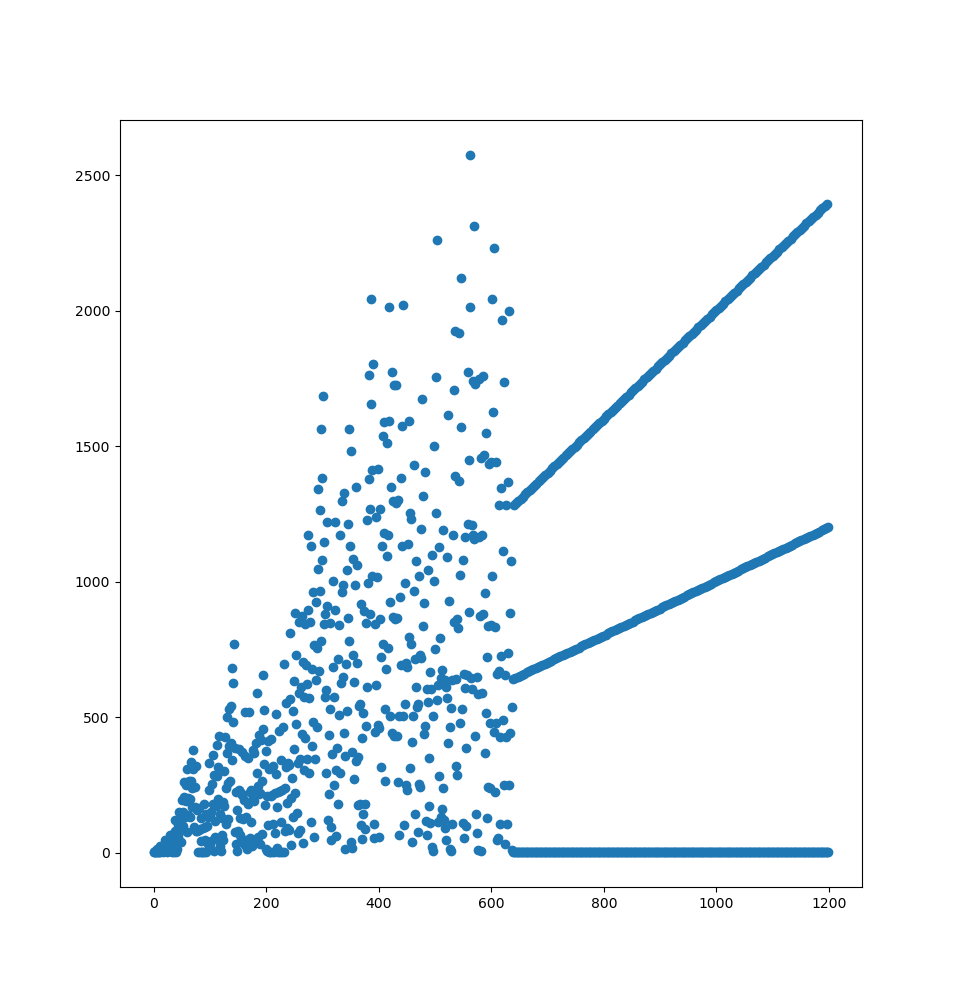This project is the implementation of a few sequences from the OEIS.
To install it, run: pip install oeis.
oeis can be used from command line as:
$ oeis --help
usage: oeis [-h] [--list] [--start START] [--stop STOP] [--plot] [--random] [--file] [--dark-plot] [sequence]
Print a sweet sequence
positional arguments:
sequence Define the sequence to run (e.g.: A181391)
optional arguments:
-h, --help show this help message and exit
--list List implemented series
--start START Define the starting point of the sequence.
--stop STOP End point of the sequence (excluded).
--plot Print a sweet sweet sweet graph
--random Pick a random sequence
--file Generates a png of the sequence's plot
--dark-plot Print a dark dark dark graphNeed a specific sequence?
$ oeis A000108
# A000108
Catalan numbers: C(n) = binomial(2n,n)/(n+1) = (2n)!/(n!(n+1)!).
Also called Segner numbers.
[1, 1, 2, 5, 14, 42, 132, 429, 1430, 4862, 16796, 58786, 208012, 742900, 2674440, 9694845, 35357670, 129644790, 477638700, 1767263190]Lazy? Pick one by random:
$ oeis --random
# A000045
Fibonacci numbers: F(n) = F(n-1) + F(n-2) with F(0) = 0 and F(1) = 1.
[0, 1, 1, 2, 3, 5, 8, 13, 21, 34, 55, 89, 144, 233, 377, 610, 987, 1597, 2584, 4181]
Want to see something cool?
$ oeis A133058 --plot --stop 1200
The oeis module expose sequences as Python Sequences:
>>> from oeis import A000045
>>> print(*A000045[:10], sep=", ")
0, 1, 1, 2, 3, 5, 8, 13, 21, 34, 55
>>> A000045[1] == A000045[2]
True
>>> A000045[100:101]
[354224848179261915075]We are using the black coding style,
and tox to run some tests, so after creating a venv and having
installed tox in it, run tox -p auto it should look like this:
$ tox -p auto
✔ OK mypy in 11.807 seconds
✔ OK flake8 in 12.024 seconds
✔ OK black in 12.302 seconds
✔ OK py37 in 15.344 seconds
✔ OK py38 in 21.041 seconds
✔ OK py39 in 21.042 seconds
______________________________________ summary ________________________________________
py37: commands succeeded
py38: commands succeeded
py39: commands succeeded
flake8: commands succeeded
mypy: commands succeeded
black: commands succeeded
congratulations :)
There's two ways to implement a serie: by implementing it as a function, or by implementing it as a a generator.
For serie where the result only depend of the its position, like
A004767 which is a(n) = 4*n + 3, it's straightforward as a function,
use the @oeis.from_function() as a decorator to setup the plumbing:
@oeis.from_function()
def A004767(n: int) -> int:
"""Integers of a(n) = 4*n + 3."""
return 4 * n + 3It has the advantage of having fast direct access:
print(A004767[1_000_000])can be done by calling your function a single time.
Beware: No "offset correction" is done magically. If the offset is 1,
don't expect your function to be called with n=0.
Some series need the previous (or previouses) values to be computed,
they can't easily be implemented as functions, you can implement them
as generators, in this case use the @oeis.from_generator()
decorator:
@oeis.from_generator()
def A000045() -> Iterable[int]:
"""Fibonacci numbers: F(n) = F(n-1) + F(n-2) with F(0) = 0 and F(1) = 1."""
a, b = (0, 1)
yield 0
while True:
a, b = b, a + b
yield aBeware: Just yield the actual serie values, don't care about the
offset by trying, for example, to return None or 0 to shift the
results.
So, to be clear, those two implementations are strictly equivalent:
@oeis.from_generator()
def A008589() -> Iterable[int]:
"""Multiples of 7."""
return (n * 7 for n in count())@oeis.from_function()
def A008589(n: int) -> int:
"""Multiples of 7."""
return n * 7And if the offset were 1, only the generator would change to start at 1 (the function does not need to change, as 1 would be given as a parameter):
@oeis.from_generator(offset=1)
def A008589() -> Iterable[int]:
"""Multiples of 7."""
return (n * 7 for n in count(1))There's two kind of requirements projects usually pin:
- The actual project dependencies (numpy, ...).
- The test dependencies (pytest, ...).
Anyway users will just pip install (or apt install or whatever)
the project and expect it to work. If there's an incompatiliby with a
dependency we need to know it and restrict it explicitly in
install_requires.
Pinning project dependencies is a lie: it works in the CI, but may not work in users environments.
Pinning test dependencies looks comfortable as if the tests pass today they'll pass tomorrow, but it also mean running outdated linters most of the time.
Finally pinning dependencies may just not be possible: there could be no set of frozen dependencies that work on every version of Python you want to test.
So the idea is: Let's not pin anything and learn issues the hard way before the users find them.
Yes it means the CI could break anytime. But it's better than a end user finding the bug.


